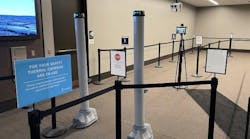Lawrence Livermore Laboratory showcased its biological and radiological detection technology Wednesday to the secretary of Homeland Security on his first visit to the lab.
The science, technology and skills at the lab "are precisely what we need to enable us to get real-time detection of biological hazards and give us the capability to respond and mitigate potential harmful encounters," said Michael Chertoff at a news conference following a day of briefings at the lab.
Added Livermore lab director Michael Anastasio, "Throughout his visit, we've been showing him how we at Lawrence Livermore and our sister laboratory Sandia across the street are working very aggressively to assist the Department of Homeland Security to win the war on terrorism."
Chertoff said that, in addition to biological hazards, his discussions at the lab focused on developing the next generation of detection technology for nuclear threats and making existing technology smaller, cheaper, more effective and more precise.
He also mentioned the recent London bomb attacks and praised the lab for being an enormous help to local transit authorities to determine where to focus their efforts to prepare for attacks.
"We have to be careful not to let what occurred last week or three weeks ago beguile us from looking at things that could happen in the future that could have even more catastrophic consequences," Chertoff said.
There also were brief meetings with scientists working on several different radiological and biological detection systems such as the "biobriefcase," a portable detector that can sense viruses, toxins and bacteria in the air. The system, which takes up less than 2 square feet and literally fits inside a large briefcase, is scheduled to begin field testing in October.
The biobriefcase eventually will be even smaller, said bioengineer Allen Christian. The goal is to make it easy for people like Secret Service members, police or firefighters to carry it anywhere the air needs to be monitored for biological hazards. Once it is tested and ready to go, it could be used in situations such as the London bomb attacks to quickly determine if bioweapons have been released.
"That's precisely what you'd use it for," said Christian.
Another biodetection system slated to become more portable is the Bioaerosal Mass Spectrometer. Currently about the size of a washer and dryer set, the spectrometer uses a laser to identify and analyze individual bacteria, virus or toxin cells in the air.
Multiple spectrometers could be deployed to monitor a city or region for biological hazards, said chemist Eric Gard who heads the lab's defense biology division. "You could watch a pathogen move through the area and know where it was going before it got there," he said.
The spectrometer shown to Chertoff on Wednesday had just returned from a four-month field test at San Francisco International Airport where it performed well.
Gard hopes to have the system slimmed down to a fifth of its current size in about three years, making it far more portable and useful. Right now, it takes a lift and a truck to transport the machine.
"It needs to be a countertop device so it can be used in an office," Gard said.
Livermore also is working on radiological detectors such as the Adaptable Radiation Area Monitor, which can sit at the side of the road and monitor passing vehicles for radiological hazards.
"You can scan traffic as it goes by without even stopping it," said physicist Dan Archer. "If you get a radiation hit, it will tell you what it is. If it is a medical patient, you can let it go."
While the roadside device can identify radiation from uranium, it can't tell the difference between weapons-grade uranium and fuel-grade uranium. But a hand-held detector known as the RadScout can, said physicist Dan Dietrich.
"It will tell you if it's depleted uranium or enriched uranium," said Dietrich. The RadScout can determine very precisely what is causing radioactivity. It has been available since last year and is already in use by the FBI, customs, border patrol and the military.
Both of these radiation detectors can be found in the lab's new Department of Homeland Security Mobile Van, intended to scan cargo for radiological hazards. It was developed in response to feedback from law enforcement.
"We can drive it to some place, fire it up and have it operational in a few minutes," said electrical engineer David Weirup.
Two vans have been built and tested at the lab so far, at a cost of about $200,000 each. Commercial versions should be significantly less expensive, Weirup said.
While in California, Chertoff also met with Gov. Arnold Schwarzenegger and local authorities about how to establish a network for getting local police and security officials the information, intelligence and technology they need to intercept, prevent and respond to threats.
Chertoff is scheduled to speak at the Commonwealth Club of California tonight.

